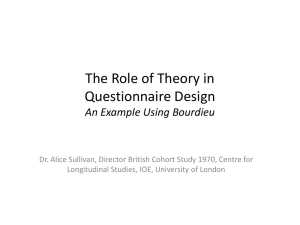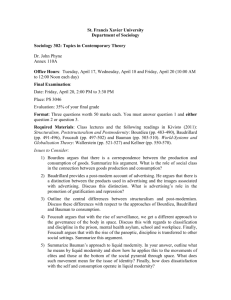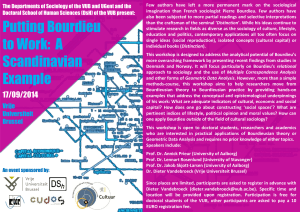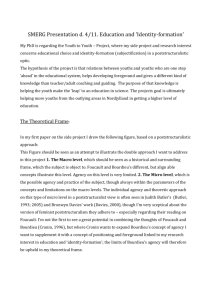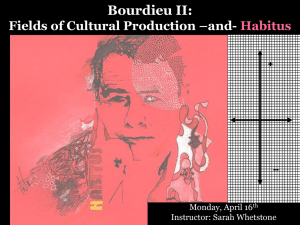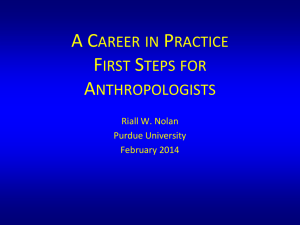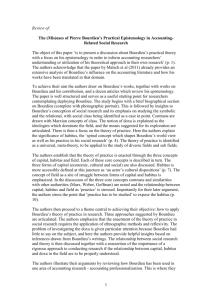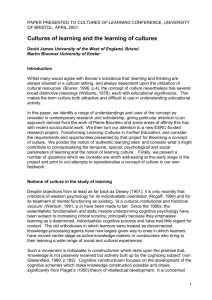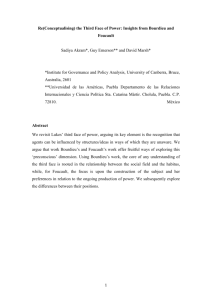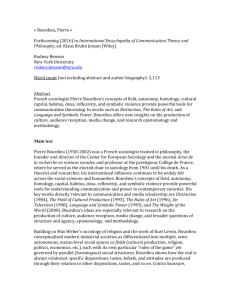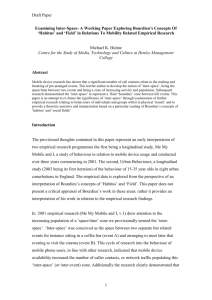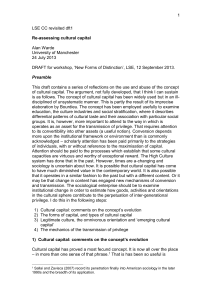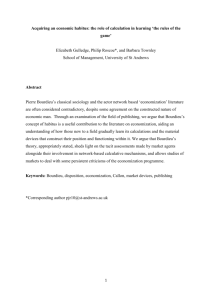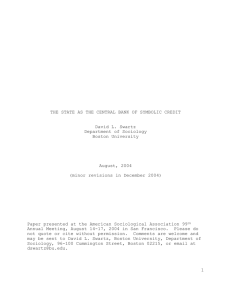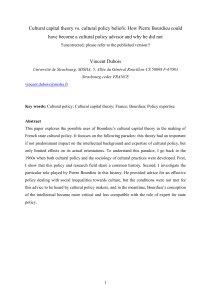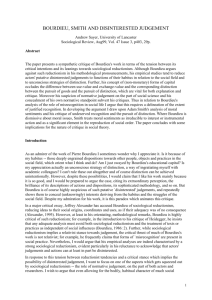Iara Cury Trinity Term, Week#3 Elizabeth Ewart Power, Agency and
advertisement
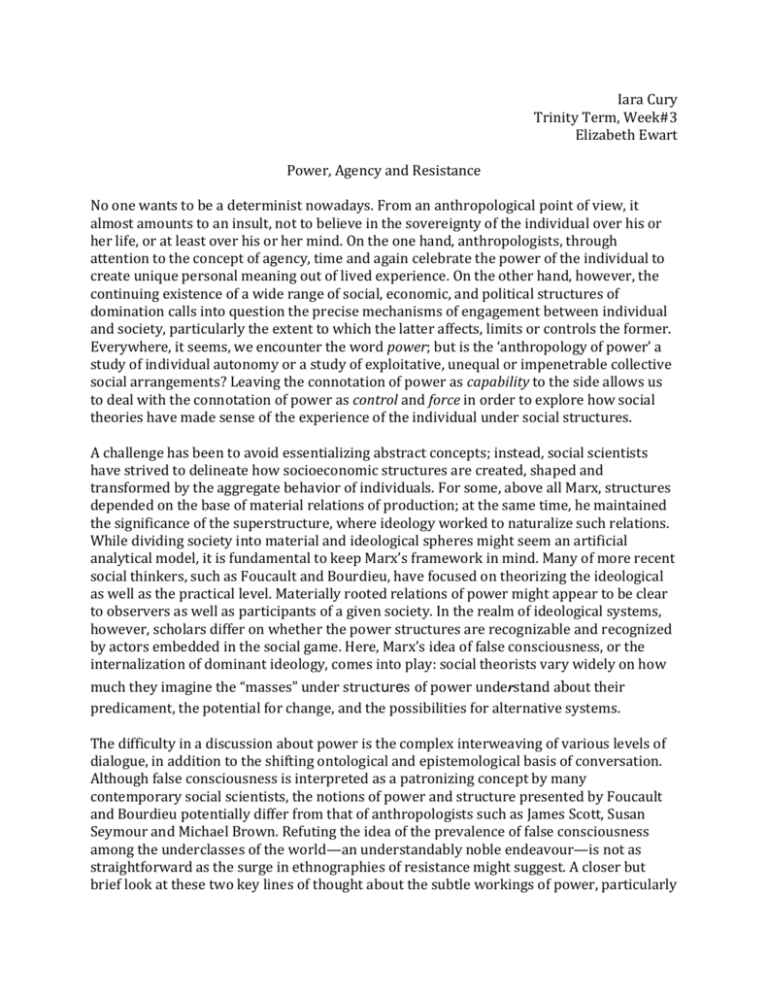
Iara Cury Trinity Term, Week#3 Elizabeth Ewart Power, Agency and Resistance No one wants to be a determinist nowadays. From an anthropological point of view, it almost amounts to an insult, not to believe in the sovereignty of the individual over his or her life, or at least over his or her mind. On the one hand, anthropologists, through attention to the concept of agency, time and again celebrate the power of the individual to create unique personal meaning out of lived experience. On the other hand, however, the continuing existence of a wide range of social, economic, and political structures of domination calls into question the precise mechanisms of engagement between individual and society, particularly the extent to which the latter affects, limits or controls the former. Everywhere, it seems, we encounter the word power; but is the ‘anthropology of power’ a study of individual autonomy or a study of exploitative, unequal or impenetrable collective social arrangements? Leaving the connotation of power as capability to the side allows us to deal with the connotation of power as control and force in order to explore how social theories have made sense of the experience of the individual under social structures. A challenge has been to avoid essentializing abstract concepts; instead, social scientists have strived to delineate how socioeconomic structures are created, shaped and transformed by the aggregate behavior of individuals. For some, above all Marx, structures depended on the base of material relations of production; at the same time, he maintained the significance of the superstructure, where ideology worked to naturalize such relations. While dividing society into material and ideological spheres might seem an artificial analytical model, it is fundamental to keep Marx’s framework in mind. Many of more recent social thinkers, such as Foucault and Bourdieu, have focused on theorizing the ideological as well as the practical level. Materially rooted relations of power might appear to be clear to observers as well as participants of a given society. In the realm of ideological systems, however, scholars differ on whether the power structures are recognizable and recognized by actors embedded in the social game. Here, Marx’s idea of false consciousness, or the internalization of dominant ideology, comes into play: social theorists vary widely on how much they imagine the “masses” under structures of power understand about their predicament, the potential for change, and the possibilities for alternative systems. The difficulty in a discussion about power is the complex interweaving of various levels of dialogue, in addition to the shifting ontological and epistemological basis of conversation. Although false consciousness is interpreted as a patronizing concept by many contemporary social scientists, the notions of power and structure presented by Foucault and Bourdieu potentially differ from that of anthropologists such as James Scott, Susan Seymour and Michael Brown. Refuting the idea of the prevalence of false consciousness among the underclasses of the world—an understandably noble endeavour—is not as straightforward as the surge in ethnographies of resistance might suggest. A closer but brief look at these two key lines of thought about the subtle workings of power, particularly at Bourdieu’s conceptualization of the habitus, is necessary before we can approach current critiques and ethnographic evidence weighing towards the primacy of agency and resistance. According to Foucault, “power is not an institution, and not a structure; neither is it a certain strength we are endowed with; it is the name that one attributes to a complex strategical situation in a particular society” (1998, p.93 cited in Rapport and Overing, 2007, p.341). Leaving behind the intrinsic association of power to the economic base, Foucault studied disciplinary practices accomplished through institutions such as clinics, mental hospitals and prisons. His conclusion was that even if it was found in diffuse, highly contingent and contested social arrangements, power was fundamentally tied to the construction and social regulation of knowledge: routinized ways of thinking and knowing, or a discursive imaginary outside of which thoughts could not be formulated. Foucault’s take on false consciousness might be that as long as people adhere to positivistic, modernist, standardized frameworks of knowledge, epitomized by the sciences, they are naturalizing and propagating arbitrary structures of power. In turn, Bourdieu’s theory of practice put forward the concept of habitus, a set of durable, transposable dispositions that loosely shaped the perceptions, thoughts and actions of an individual. According to Bourdieu, the habitus developed the subjective expectations of objective probabilities and the physical embodiment of social values, both of these ordinarily beyond the “grasp of consciousness” (Jenkins, 1992, p.75). The internalization of dominant structures for him lay in the fact that “the most improbable practices are therefore excluded as unthinkable, by a kind of immediate submission to order that inclines agents to make a virtue of necessity, to refuse what is anyway denied and to will the inevitable” (p.81). As much as Bourdieu could not deny the fact that individuals make seemingly independent choices, he believed that these are chosen from the given repertoire of the habitus—they are far from free and autonomous decisions as commonly portrayed. While critics argue that Bourdieu never explained how exactly the habitus influenced individual behavior, ignoring the potential for knowledgeable, deliberate decision-making, his conceptualization has been powerful enough to influence much of subsequent social theory and study. While characterizing ideas like power/knowledge and habitus as models of false consciousness risks distorting complex theories to fit Marx’s original formulation, the fact that both Foucault and Bourdieu understood power to be insidious and deeply rooted beyond individual awareness is often interpreted as a theoretical nod to determinism. The 1980s saw the field of subaltern studies emerge from the work of researchers paying close attention to the dynamics of power relations at the micro level. For these academics, recognizing that resistance existed apart from full-blown revolutionary movements was key: if power acted in subtle ways, so did resistance. The task at hand was to study hitherto neglected strains of opposition; such undercurrents of defiance and struggle would demonstrate the inadequacy and even naiveté of ideas of false consciousness. James Scott, in his 1985 study of Malaysian peasants, Weapons of the Weak, focused on the recognition and analysis of such everyday forms of resistance. What he discovered was that beneath a surface of compliance and order peasants staged a continuous campaign of resistance through pilfering, feet dragging, sabotage, and gossip. In his subsequent book, Domination and the Arts of Resistance, Scott cogently elaborates on the existence of two “transcripts”: a public transcript that broadcasts hegemonic discourses and various hidden transcripts on the part of the powerful as well as subordinate groups that strongly diverge from public representations. For Scott, “any analysis based exclusively on the public transcript is likely to conclude that subordinate groups endorse the terms of their subordination and are willing, even enthusiastic, partners in that subordination” (1990, p.4). Scott’s view is that this analytical mistake is often responsible for the popularity of the idea of ideological hegemony and he goes on to discredit both “thick” and “thin” theories of false consciousness. According to him, oppressed people’s capacity for imagining the absence of oppression or total reversal of oppressive systems, in conjunction with subtle and not so subtle political demands and protest, absolutely challenges the alleged naturalization of domination in most cases (Scott, 1990, p.80). Along Scott’s seminal work, the social sciences have produced a substantial amount and variety of studies on the subject of power, agency and resistance. Contemporary anthropologists have often turned to historical methods and records in their attempts to understand the formation and evolution of dominant ideologies and their influence on individual lives. Books such as Maurice Bloch’s From Blessing to Violence and Jean Comaroff’s Body of Power, Spirit of Resistance attest to the usefulness of tracing the dialectics between individual and material and symbolic structures of power diachronically. For Comaroff in particular, resistance in colonial and post-colonial settings has not been only about opposition, but also about a “purposive act of reconstruction” focused mainly on “the attempt to reassert control, to return to the world some form of coherence and tractability” (p.260). Another kind of study—an example of less historical but unusually sharp ethnography—Paul Willis’ book, Learning to Labour, illustrates well how subordinate groups resist hegemonic orders in unexpected and uncontrollable ways. Observing a group of working class “lads” in secondary school, Willis portrays how oppositional behavior can backfire in the sense of maintaining the status quo. At the same time, processes of social reproduction remain far from deterministic—subordinate subcultures are neither controlled nor ideologically co-opted by ruling classes or institutions. Yet in addition to these meticulous historical and ethnographic studies, a large volume of ethnography on muted and culturally mediated resistance has been produced. Michael Brown explicates this trend by noting, “when the great metanarratives of the modern era…became impossible to sustain, intellectuals shifted their focus to the political nuances of daily life”(1996, p.729). At the same time, however, he charges anthropologists with the indiscriminate and lax analytical use of the concept and label of resistance, stating that an overreliance on the explanatory ‘power’ of the power lens ultimately fails since “society cannot be relegated to the conceptual status of a penal colony” (p.734). Presenting the thought-provoking ethnographic case of the Asháninkas of the Peruvian Amazon, Brown indicts himself as the example of a well-meaning anthropologist who too quickly applied the label of resistance to activities that involved quite convoluted religious and cultural elements. While several Asháninkas followed the revolutionary lead of a shaman and joined the armed struggle of MIR in the 1960s, many others did not. Comprehending the reasons for each individual’s decision would entail realizing in depth the “specificity of Asháninka dreams of world transformation” as well as the “the internal struggles that these touched off within Asháninka society itself” (p.731). The point, as Sherry Ortner expresses clearly, is that acts of resistance inevitably contain a large measure of ambiguity and subjective ambivalence emerging “from the intricate webs of articulations and disarticulations that always exist between dominant and dominated” (1995, 176). Other points of criticism against the wave of resistance studies are the problems inherent in essentialized, simplistic or unfounded readings of resistance. According to Susan Seymour, the “theoretical gap between…discussions of large-scale social processes and the actual thoughts and motivations of individuals engaged in them” remains wide open given the “anti-psychological” attitude of many anthropologists (2006, p.304-5). From her perspective, investigating the issue of “how individuals learn a system of cultural meanings…and, as a result, are motivated to act”, be in contrary to or in support of dominant systems, is fundamental if we are to understand emergent lived practices (p.304, emphasis in original). In her article, “Resistance”, Seymour cites three ethnographic cases in which other scholars have to some extent misinterpreted the occurrence of resistance. Analysing G. Raheja and A. Gold’s book, Listen to the Heron’s Words, Seymour questions whether what these anthropologists take to be critical acts veiled in traditional yet ideologically subversive mythological accounts truly constitutes resistance. She states, “to the extent that they currently provide safe and restricted outlets for women’s dissatisfactions, one must argue that they are actually anti-subversive” (p.312). Interpreting resistance suddenly becomes a complex, multi-dimensional project much beyond simply detailing counterhegemonic discourses voiced by subordinate groups. Sherry Ortner makes a similar point in her article, “Resistance and the problem of ethnographic refusal”. In this piece she questions one-dimensional models of resistance, challenging anthropologists to recognize the “multiplicity of projects in which social beings are always engaged” (1995, p.191). According to Ortner, scholars of resistance have shied away from three significant aspects of situations of resistance. First, by ignoring “people’ s own forms of inequality and asymmetry” (p.180), anthropologists fail to take into account the intricate internal politics of subordinate groups. Second, by dismissing the cultural (particularly the religious) context of such groups, anthropologists fail to accept that cultural richness “allows us to understand better both resistance and its limits” (p.183). Finally, the excessive deconstruction of the subject through postmodern intellectual currents prevents the anthropologist from working out the “the intentions, desires, fears, projects…of the actors engaged in these dramas” (p.190). Overall, the picture Ortner paints of resistance is far from the romanticized idea of underground struggles waiting to burst onto the stage to expunge oppression and suffering. Rather significantly, however, is that ceasing to take resistance simply as opposition—introducing the idea that resistance “can be truly creative and transformative” (p.191), lends more refined analytical power to anthropological theorizing. Out of this prolific debate on the meaning, form and achievement of popular resistance reemerges the question of false consciousness and how realistic it is to think of the oppressed as ingenuous participants in a game absolutely stacked against them. On the one hand, whether the variety of examples of resistance provided through anthropological study lies at the same level as the constraints of power postulated by Foucault and Bourdieu remains uncertain. If the power of discourse and habitus lie in their very implicitness and thoughtless enactment, does resistance to certain structures of power imply that power actually lies much beyond or much deeper than what people perceive and imagine? Can it be that while many anthropologists speak of power as the power of the ruling classes, thinkers such as Foucault and Bourdieu referred to forms of power that encompassed the ruling classes as well as the subjugated masses in one uncontrolled, independent, even if terribly unequal, system? Returning to Marx’s legacy, is it analytically acceptable to differentiate between material and ideological relations of power? Is the ideological superstructure really determined “in the last instance” by the economic base, and how does that influence our understanding of power? On the other hand, Foucault and Bourdieu both spoke of embodied forms of power, yet the question of whether resistance movements can ever dismantle the bodily habits denotative of structures of power that we acquire from the first years of life also lingers unanswered. Ortner states that “if a relatively conscious intention to resist is not present, the act is not one of resistance” (1995, p.175), but what constitutes conscious intention? Does consciousness imply linguistic discernment? Can resistance ever be non-linguistic? Instinctual perhaps? Is non-linguistic resistance necessary to overcome the embodiment of hegemonic orders? Or is reflective, linguistically-based conscientization required in order to tease out the subtle habits, tributes to power, residing in our bodies? Finally, returning to power as capability, wherein lies the power of the individual and how does individual agency stack up against structures of power? How empowered are people to pursue their own productive, cultural and spiritual projects on the face of severe social, political and economic constraints? Certainly individuals seem to have some power to transform both personal and collective circumstances, and it is on such a note that Bourdieu is harshly criticized. Yet it is a fine line to state that positive thinking can transform the world, while so many people live in abject poverty, suffer appalling physical violence, and subsist at the mercy of unstable, unequal socioeconomic systems. Today, anthropology faces a painful dichotomy. Anthropologists enjoy celebrating what Rapport and Overing call the existential dimension of agency—the power of the individual to imagine “going beyond a given situation, a set of circumstances, a status quo” and to act from that imaginary (2007, p.6). Meanwhile we are constantly confronted by a seemingly more palpable (yet entirely abstract) genre of power—that of coercive control over resources and unreasonable violence. Reconciling the big and the small, the global and the local dimensions of power without underestimating the elusive capacities of the human spirit—that is one of our most worthy challenges. Bibliography Brown, M. 1996. “On resisting resistance”. American Anthropologist 98(4):729-735. Cheater, A. (ed.) 1999. The Anthropology of Power. London: Routledge. Comaroff, J. 1985. Body of power, spirit of resistance. Chicago: University of Chicago Press. Foucault, Michel. [1976] (1998). The History of Sexuality Vol. 1: The Will to Knowledge. London: Penguin Jenkins, R., 1992. Pierre Bourdieu. London: Routledge. Ortner,S 1995. ‘Resistance and the problem of ethnographic refusal’ in Comparative Studies in Society and history Vol.37 (1): 173-93 Rapport, N. 2003. I am Dynamite. London: Routledge. Rapport, N. and J. Overing. 2007. Social and Cultural Anthropology: The Key Concepts. London: Routledge. Scott, J. 1985. Weapons of the Weak. New Haven: Yale University Press. Scott, J. 1990. Domination and the Arts of Resistance. New Haven: Yale University Press. Seymour, S. 2006. “Resistance”. Anthropological Theory 6(3):303-321.

